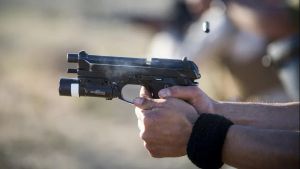JAKARTA - The KRI Nanggala-402 submarine SAR operation is increasingly being rushed. Oxygen reserves are running low. We got into this problem. How does the oxygen system work in a submarine? What is the risk of running out of oxygen? Regardless, hope is still there.
The oxygen reserves of KRI Nanggala-402 can only last for the next 24 hours, said Chief of Naval Staff Admiral Yudo Margono in a press conference Thursday, April 22. This means that oxygen is only available until Saturday, April 24, at 03.00 WITA.
The estimate was deduced from the last contact of the KRI Nanggala-402 crew on Wednesday, April 21, at 03.00 WITA. Before contact was lost, KRI Nanggala-402 had asked permission to dive in Bali waters.
Today the Head of the Indonesian Armed Forces Information Center Maj. Gen. Achmad Riad reiterated the situation. On that basis, today's search will be maximized.

"Anyway, until the deadline tomorrow at 3:00 am, it is maximized today", he said in a press conference at the I Ngurah Rai Air Force Base, Badung, Bali, Friday, April 23.
The search area will target a point 60 miles from the waters north of Bali. The point was determined based on the discovery of the fuel spill allegedly belonging to KRI Nanggala-402 on Thursday, April 22.
"So the area (the search) that we got yesterday was from the oil spill, diesel spill, or whatever came out of it. The area is still around 60 miles from the waters north of Bali", said Achmad Riad.
Submarine crew breathing system

Blackout from the start is a condition of concern. In normal diving mode, the KRI Nanggala-402 oxygen system can continue to run. However, in blackout conditions, the oxygen system can only last up to 72 hours.
The KRI Nanggala-402 submarine is powered by diesel-electric. This ship belonging to the Indonesian Air Force has a time limit of several days in a submerged state because the engine must continue to run and the ship needs air when it is in its lowest condition.
To recharge the battery and exchange fresh air, the boat uses a snorkel mast, popping it up to the surface of the sea. Quoting How Stuff Works, oxygen in a submarine is released through oxygen generators, compression tanks, or by several oxygen cylinders that automatically work under certain conditions.
Oxygen is released periodically as long as the submarine operates at certain time intervals. The submarine is also equipped with a computerized system capable of detecting decreased oxygen levels in the ship's cabin.

One of the most important things in this system is how the submarine produces a source of oxygen by entering seawater through the electrolysis process. In an emergency when the system fails, the submarine has a large oxygen tank capable of supplying a reserve oxygen level to the hull.
Apart from oxygen, the submarine is also equipped with a system that regulates the carbon dioxide content in the cabin. We know, humans breathe both ways: inhaling oxygen and re-releasing it in the form of carbon dioxide.
In open areas, we don't have to worry about carbon dioxide. However, in the hull of a submarine, exhaled carbon dioxide can pose a serious threat to humans. That's where the carbon dioxide regulating system in a submarine comes in.
How to? This is done with the help of soda lime which is in a device called a 'scrubber'. Lime soda is a good CO2 absorber.
Not just to neutralize carbon dioxide. Lime soda can also be used to remove acidic indoor contaminants.
[/ read_more]
Risk of running out of oxygen
Of course, we hope that the entire crew of the KRI Nanggala-402 can be found before the oxygen supply runs out. Lack of oxygen can be dangerous for the crew.
In general, the lack of oxygen in the body is called hypoxia. In hypoxic conditions, the first effect for a person is a weakness because oxygen is an important component for producing energy.
"Lack of oxygen in the long term will damage organs. If it hits vital organs, such as the brain and heart, it can cause death", said Doctor Nadia Hambali to VOI, Friday, April 23.
Another risk faced by the 53 crew members of the KRI Nanggala-402 was exposure to carbon dioxide. As mentioned above, exposure to carbon dioxide in confined spaces can be harmful to the body.
Nadia explained that exposure to carbon dioxide can cause a disorder called respiratory acidosis. In that condition, the pH of the blood becomes more acidic.
"In a state of acidosis, the patient may feel short of breath, headaches, and dazed or decreased consciousness", she said.
Search development
Finally, KRI Rimau detected a strong magnetic point in the search area for KRI Nanggala-402. The findings were followed up by deploying several ships, including KRI Rigel.
"It is hoped that this afternoon or evening (KRI Rigel, red) can be docked soon so that it can be established or build and plan for more detailed search activities", said Achmad Riad during a press conference at I Ngurah Rai Air Force Base, Badung, Bali, Friday, 23 April.
KRI Rigel is an important hope. The ship has the specific ability to take three-dimensional images under the sea. KRI Rigel can be used to capture various images around the SAR search location or full covered.
[/ read_more]
To perform full covered depth detection, KRI Rigel will use Multibeam Echosounder EM2040 and Side Scan Sonar. KRI Rigel is a ship used by the Indonesian Navy to provide hydro-oceanographic data or marine maps for navigation.
KRI Rigel is said to be the most advanced underwater survey vessel in Asia for the Type of Assisted Hydro-Oceanography (BHO). According to records, KRI Rigel was brought in in cooperation with the Ministry of Defense with OCEA France.
Apart from being a survey vessel, the KRI Rigel 933 can also be used for military operations. KRI Rigel has submachine weapons caliber 20 millimeters and caliber 12.7 millimeters.

Also, KRI Rigel is qualified in SAR activities. Specifically, the KRI Rigel is a Multi-Purpose Research Vessel (MPRV) type vessel. Regarding underwater imaging, KRI Rigel is equipped with Autonomous Underwater Vehicle (AUV) equipment.
This equipment serves for underwater imaging activities up to a depth of one thousand meters. With this technology, KRI Rigel can also periodically send data back to the main ship, the BHO ship.
KRI Rigel is also equipped with a Remotely Operated Vehicle (ROV), Laser Scanner - to take pictures of the land, Side Scan Sonar, Automatic Weather Station, and the deep sea Multibeam Echosounder and Singlebeam, to Conductivity Temperature Depth (CTD) equipment, and Gravity Cores.
Physically, KRI Rigel is made of aluminum and weighs 560 tons. KRI Rigel has a length of 60.1 meters and a width of 11.5 meters.
Apart from KRI Rigel, the search also involved the submarine KRI Alugoro. A total of 21 ships belonging to the TNI were deployed.
Apart from the TNI, four police ships also assisted in the search. Friendly countries also sent aid, starting from Malaysia, Singapore, India, and Australia.
"We will receive all assistance. The process will be accelerated because of the time we are chasing", said Achmad Riad.
Previously, KRI Nanggala-402 conducted a dive at around 03.00 WITA, Wednesday, April 21 to conduct torpedo launch exercise number 8. The last communication with KRI Nanggala-402 took place at 04.25 WITA when the training task force commander would authorize the firing of the torpedo.
*Read other information about KRI NANGGALA-402 or read other interesting writings from Rizky Adytia Pramana, Wardhany Tsa Tsia, also Yudhistira Mahabharata.
The English, Chinese, Japanese, Arabic, and French versions are automatically generated by the AI. So there may still be inaccuracies in translating, please always see Indonesian as our main language. (system supported by DigitalSiber.id)










